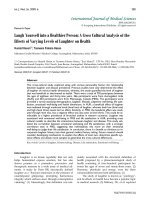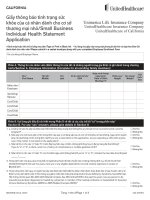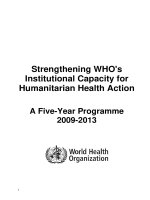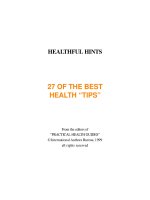26 health heart health 1
Bạn đang xem bản rút gọn của tài liệu. Xem và tải ngay bản đầy đủ của tài liệu tại đây (636.37 KB, 19 trang )
UNIVERSITY
Health
Heart Health Interpretation
and Interventions
Lesson Overview
Lab Work Interpretation
CBC- Erythrocytosis
Lipid Panel- Dyslipidemia
Hypertension
Vitamin D Status
Erythrocytosis and Polycythemia
Hematocrit Normal range: Males: 42-54% Females: 38-48%
Hematocrit is the proportion by volume of blood that contains red
blood cells.
Erythrocytosis is defines as Hemoglobin level >18.5g/dl or Hematocrit
level >52% in men.
Increased blood viscosity risk for venous thromboembolism, MI, and
CVA, evidence is limited.
Symptoms: Headaches, Lethargy, Dizziness, Increased Blood Pressure
TRT cut off point is Hematocrit >54%
Erythrocytosis and Polycythemia
Mechanisms:
Managing Erythrocytosis
1. Ensure Proper Hydration
2. Stable AAS blood levels, limit short acting esters
3. Control Estradiol levels
4. Modulate AAS stack from heavy DHT based and aromatizing
compounds
5. Limit excessive Iron intake males >8mg per day (high ferritin (iron
storage) levels)
6. Sleep apnea and hypoxia (increased CO2 on labs)
7. Blood Donation every 8-12 weeks or time frame to stay below 55%
hematocrit, based on lab work (controversial)
8. Drugs: Angiotensin II Renin Blockers (ARBs) lower hematocrit, can
cause anemia
9. Omega 3 Supplementation 2-3g per day
10. Aged Garlic 600-1200mg per day
Dyslipidemia
Dyslipidemia- abnormal amount of LDL, HDL, triglyceride and/or total
cholesterol.
LDL causal role in atherosclerosis and CHD/CVD Progression
HDL may serve a protective role, but therapeutic interventions to
increase HDL lack evidence.
High Triglycerides are associated with CHD/CVD, but if non HDL is
corrected for the risk is limited.
ApoB is a protein found on atherogenic lipoproteins, so it gives a count
of the number of these particles. LDL still primary target for therapy
intervention.
High sensitivity C Reactive Protein: general measure of inflammation,
CVD is an inflammatory condition. Independent marker for CVD risk.
Understanding Lipoproteins
image credit: a new perspective on lipid research in age-related macular degeneration - scientific
figure on researchgate. available from: />
The Lipid Panel
Total Cholesterol: Normal range 12—180mg/dL Optimal:
<180mg/dL
LDL-c: Normal Range 62-130mg/dL Optimal: <100mg/dL
HDL-c Normal 35-135mg/dL Optimal >40 males >50 females
Triglycerides: Normal 0-200mg/dL Optimal <100mg/dl
Ratio LDL/HDL optimal <3.55
Hs-CRP: <1.0mg/L low risk; >3mg/L high risk of CVD
PED Impact on Lipids
Androgenic stimulation of hepatic Lipase, liver enzyme responsible for
breakdown of HDL.
Increased ratio of LDL/HDL
Oral AAS have the largest impact on lowering HDL. In a 6 week study
comparing 6mg/day of stanozolol to 200mg/wk of test cyp, HDL
decreased 33 and 9%, respectively. LDL increased 29% with stanozolol
and decreased 16% with testosterone.
There can be a small dosage ceiling for HDL suppression with IM AAS
as well. A study comparing 300mg to 600mg of test cyp found a 21%
drop in HDL irrespective of dosage.
Estrogen is cardioprotective and over suppression of estrogen with
aromatase inhibitors can decrease HDL
Lipid Management
Dietary Intervention:
Replace saturated fats with unsaturated fats
Acceptable saturated fat intake of 6-9% of diet (grass fed beef, omega
3 eggs)
Focus the remaining fat intake on oils, nuts, seeds
Increase fiber content from fruits, vegetables and grains
Reduce processed refined grains
Increased fatty fish intake ie Sockeye Salmon
Pomegranate and Beet Root
Exercise Intervention:
Offseason: 3-5 days 20-30min moderate intensity cardio HR 120-130
bpm
Lifestyle Management:
Manage total body weight and total body fat gain in offseason setting
Lipid Management
Supplement Interventions:
Krill Oil 1-3g per day (HDL 44-55% increase, LDL 32-39% decrease)
Niacin: 500-1500mg per day (HDL 25% increase) Mixed impact?
Aged Garlic 600-1200mg (HDL +3.19mg/dl, LDL -9.65mg/dl)
Plant Sterols: 1-3g per day (12% LDL reduction)
Pantethine: 900mg per day (11% LDL reduction)
PED Intervention
Decrease AAS total dosage
Limit Oral AAS to contest prep
Limit Aromatase Inhibitors, modify stack for estrogen control
Planned time off or within physiological normal testosterone levels
Pharmacological Intervention
Metformin (decrease TG LDL-c and increase HDL-c)
Statins
Hypertension
Higher the blood pressure increased incidence of organ damage, Left
ventricular hypertrophy, stroke, HF, CKD, retinopathy.
Risk factors:
Obesity, high body weight in general
Male
Sleep apnea
Atherosclerosis
Normal Blood Pressure: below 120/80mmHg
Elevated Blood Pressure: systolic 120 to 129mmHg, diastolic
<80mmHg
Stage 1 Hypertension: systolic 130-139 mmHg, diastolic 80-89 mmHg
Stage 2 Hypertension: systolic >140mmHg, diastolic >90mmHg
PEDs on Hypertension
PED users on average have higher BP than non-users
Mechanisms included increased water retention, vascular stiffness and
increased hematocrit levels
Increased estrogen levels increases Vasopressin causing increased
sodium reabsorption. AAS users have also been shown to have higher
aldosterone levels as well.
HGH increases renin and aldosterone increasing sodium reabsorption
effect seen within 2-4 days of use.
The large water increase intra and extra cellular increases blood
pressure
Increased activation of the sympathetic nervous system increases
blood pressure. (ie clenbuterol, ephedrine, Yohimbine,T3)
Hypertension Interventions
Lifestyle Intervention
Maintain lower body and leaner offseason state
PED intervention
Lower AAS/GH dosage if able
Modulate stack to limit aromatizing and water retention compounds
Micro dose HGH over large bolus
Use an aromatase inhibitor to lower estrogen
Limit stimulating drugs (clen, ephedrine, T3 in high doses)
Drug Intervention
Blood pressure medications
Telmisartin BP med of choice (Angiotensin receptor blocker)
Lowers BP via Renin angiotensin aldosterone system (RAAS),
renalprotective, LVH protective, increases IGF1, decreases visceral fat,
increased insulin sensitivity.
Telmisartan
A key player in CVD is the renin–angiotensin–aldosterone system (RAAS) activation causing inflammation vasoconstriction, thrombosis, fibrosis and superoxide formation.
Telmisartan blocks the receptor for angiotensin
Once daily dosing as half life is 20-24 hours
Hypertension (Weber 2010):
More effective than ACE inhibitor (lisinopril, enalapril, perindopril)
Metabolism:
Reduced incidence of new onset diabetes
Left Ventricular Hypertrophy:
25 In the TRANSCEND study, telmisartan
The rate of new onset of LVH was lower in the telmisartan group than in the placebo group (5.0 % versus 7.9 %, respectively p<0.001]).
[
statistically significantly reduced LVH overall by 21 % (p=0.0017) versus placebo
Renal Function:
“In the AMADEO study, telmisartan reduced the urinary protein:creatinine ratio significantly more than losartan after 52 weeks (29.8 % versus 21.4 % from baseline, respectively
[p=0.027]”
Atrial Fibrillation:
“telmisartan is effective in preventing AF recurrence in hypertensive patients with a history of AF71 and more effective thanramipril in reducing the recurrence (telmisartan 12.9 %,
p<0.01 versus amlodipine and p<0.05 versus ramipril; ramipril 25.5 %, p<0.01 versus amlodipine)”
Endothelial Function:
“ telmisartan reduced arterial stiffness to a greater extent than placebo in hypertensive patients with type 2 diabetes.”
Inflammation:
“shown to reduce markers of inflammation, such as C-reactive protein and interleukin-6, at least as effectively as ACE inhibitors”
Erytrocytosis (Nishida 2012):
ARB monotherapy showing significant reduction in RBC, Hematocrit and hemoglobin
PPAR Y activation and insulin sensitivity (Suksomboon 2012):
“Adiponectin is an adipokine produced exclusively by adipo- cytes. Its production is regulated by PPAR-c activation. Adipo- nectin is generally considered as a key protein regulating
insulin resistance and metabolic syndrome.65,66 It promotes free fatty acid oxidation and insulin sensitivity in muscle and iver.
l
Overall, telmisartan significantly increased adiponectin
level (mean difference, 0Ỉ93 lg/dL; 95% CI 0Ỉ28 lg/dL to 1Ỉ59 lg/dL; P = 0Ỉ005) when compared with other ARBs”
“Eight trials involving a total of 763 patients met the inclusion criteria. Telmisartan was superior to other ARBs in reducing FPG level (mean difference, )8Ỉ63 mg/dL; 95% CI )12Ỉ29
mg/dL to )4Ỉ98 mg/dL; P < 0Ỉ00001) and increasing adiponectin level (mean difference, 0Ỉ93 lg/dL; 95% CI 0Ỉ28 lg/dL to 1Ỉ59 g/dL;
l
P = 0Ỉ005). At 80 mg dose, telmisartan may
reduce FPI level and HOMA-IR"
Hypertension Intervention
Dietary Intervention:
Increase fruit and vegetable intake
Increase food high in calcium, magnesium and potassium
Limit excessive salt intake if responsive
Increase nitrate rich foods (beets, spinach, arugula)
Increase Olive Oil intake
Ensure Optimal Hydration
*follow lipid diet intervention recommendations
Exercise Intervention:
Offseason: 3-5 days 20-30min moderate intensity cardio HR 120-130 bpm
Supplement Intervention
Omega 3 2-3g per day (↓ TXA2 and inflammation; ↑ vasodilator PGs; ↑ NO synthase;
↓ insulin resistance; ↓ RAAS)
Cocoa Flavanols 500mg: (Antioxidation; free radical scavenging; ↑ NO production and
endothelial function; ↓ inflammation; ↓ ROS production (NADPH oxidase inhibition))
Beet Root Juice (↑ NO availability)
Coenzyme Q10 100-200mg (effects vascular endothelium)
Garlic 600-1200mg (↑ NO production; ↑ H2S; ↑ bradykinin; ↓ catecholamine sensitivity;
ACE inhibition; calcium channel blocking)
Ensure optimal Vitamin D status
Vitamin D
Vitamin D has roles in the immune system, GI tract, kidneys,
parathyroid gland, cardiovascular system, and skeletal muscle.
The serum marker for Vitamin D status is the Vitamin D metabolite
25(OH)D. Vitamin D deficiency and insufficiently are defined as a
serum concentration of 25(OH)D less than 20ng/mL and 30ng/mL,
respectively
Vitamin D deficiency has been linked to inflammation, depression,
cancer risk, cardiovascular disease risk, insulin resistance, and
neurodegeneration
Vitamin D has a role in skeletal muscle force production and protein
synthesis.
Vitamin D
The most recent guidelines suggest a serum level of 40-60ng/mL as
the minimum for protecting against certain chronic diseases and above
40ng/mL we see improvement in athletic performance.
Potentially athletes that are insufficient may require 5000IU of vitamin
D3 per day for 4-8 weeks to achieve an optimal serum Vitamin D level
Once optimal serum levels are achieved 1000-2000IU Vitamin D3 per
day can be utilized for maintenance
Supplement Vitamin K2 along with Vitamin D3. K2 determinant in
where calcium is laid.
Vitamin K2 supportive in reversal of calcification of arterial walls.
Prefer: Menaquinone K2-7 “mk-7” stays longer in body 200mcg per
day
References
Ohlander SJ, Varghese B, Pastuszak AW. Erythrocytosis Following Testosterone Therapy. Sex Med Rev. 2018 Jan;6(1):77-85. doi: 10.1016/j.sxmr.2017.04.001. Epub 2017 May 16. PMID: 28526632; PMCID: PMC5690890.
Wulffelé MG, Kooy A, de Zeeuw D, Stehouwer CD, Gansevoort RT. The effect of metformin on blood pressure, plasma cholesterol and triglycerides in type 2 diabetes mellitus: a systematic review. J Intern Med. 2004
Jul;256(1):1-14. doi: 10.1111/j.1365-2796.2004.01328.x. PMID: 15189360.
Llewellyn W. Anabolics. Jupiter, FL: Molecular Nutrition LLC; 2017.
Hansen TK, Møller J, Thomsen K, Frandsen E, Dall R, Jørgensen JO, Christiansen JS. Effects of growth hormone on renal tubular handling of sodium in healthy humans. Am JPhysiol Endocrinol Metab. 2001 Dec;281(6):E132632. doi: 10.1152/ajpendo.2001.281.6.E1326. PMID: 11701449.
Jung, H.C., et al., Correcting Vitamin D Insufficiency Improves Some, But Not All Aspects of Physical Performance during Winter Training in Taekwondo Athletes. Int J Sport Nutr Exerc Metab, 2018: p. 1-25.
Ogan D, Pritechett K. Vitamin D and the Athlete: Risks, Recommendations, and Benefits. Nutrients. 2013 Jun; 5(6):1856-1868.
Jones SD Jr, Dukovac T, Sangkum P, Yafi FA, Hellstrom WJ. Erythrocytosis and Polycythemia Secondary to Testosterone Replacement Therapy in the Aging Male. Sex Med Rev. 2015 Apr;3(2):101-112. doi: 10.1002/smrj.43.
Epub 2015 Dec 2. PMID: 27784544.
Bunea R, El Farrah K, Deutsch L. Evaluation of the effects of Neptune Krill Oil on the clinical course of hyperlipidemia. Altern Med Rev. 2004 Dec;9(4):420-8. PMID: 15656713.
Shabani E, Sayemiri K, Mohammadpour M. The effect of garlic on lipid profile and glucose parameters in diabetic patients: A systematic review and meta-analysis. Prim Care Diabetes. 2019 Feb;13(1):28-42. doi:
10.1016/j.pcd.2018.07.007. Epub 2018 Jul 23. PMID: 30049636.
Mani P, Rohatgi A. Niacin Therapy, HDL Cholesterol, and Cardiovascular Disease: Is the HDL Hypothesis Defunct?.Curr Atheroscler Rep. 2015;17(8):43. doi:10.1007/s11883-015-0521-x
Ras RT, Geleijnse JM, Trautwein EA. LDL-cholesterol-lowering effect of plant sterols and stanols across different dose ranges: a meta-analysis of randomised controlled studies. Br J Nutr. 2014;112(2):214-219.
doi:10.1017/S0007114514000750
Evans M, Rumberger JA, Azumano I, Napolitano JJ, Citrolo D, Kamiya T. Pantethine, a derivative of vitamin B5, favorably alters total, LDL and non-HDL cholesterol in low to moderate cardiovascular risk subjects eligible for
statin therapy: a triple-blinded placebo and diet-controlled investigation. Vasc Health Risk Manag. 2014;10:89-100. Published 2014 Feb 27. doi:10.2147/VHRM.S57116
Weber MA. Telmisartan in high-risk cardiovascular patients. Am J Cardiol. 2010 Jan 4;105(1 Suppl):36A-43A. doi: 10.1016/j.amjcard.2009.10.008. PMID: 20102972.
N. Suksomboon; N. Poolsup; T. Prasit (2012). Systematic review of the effect of telmisartan on insulin sensitivity in hypertensive patients with insulin resistance or diab etes. , 37(3), 0–0.doi:10.1111/j.13652710.2011.01295.x
Nishida, Y., Takahashi, Y., Nakayama, T. et al. Comparative effect of angiotensin II type I receptor blockers and calcium channel blockers on laboratory parameters in hypertensive patients with type 2 diabetes. Cardiovasc
Diabetol 11, 53 (2012). />









